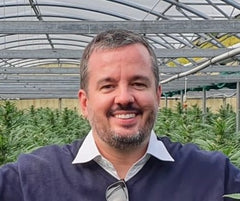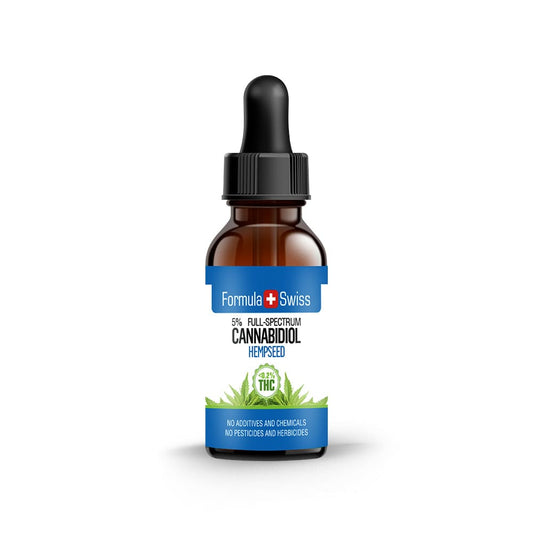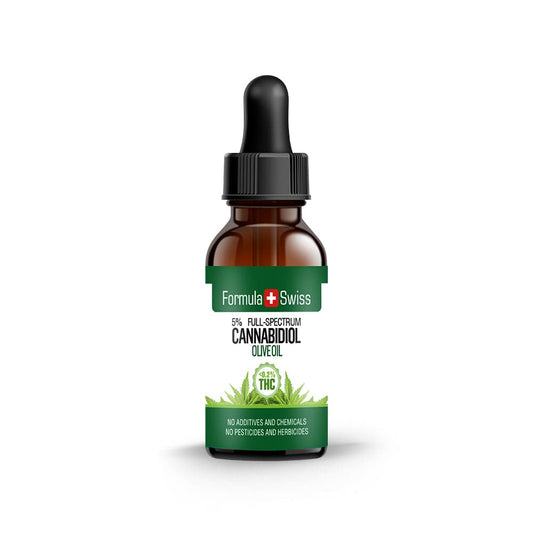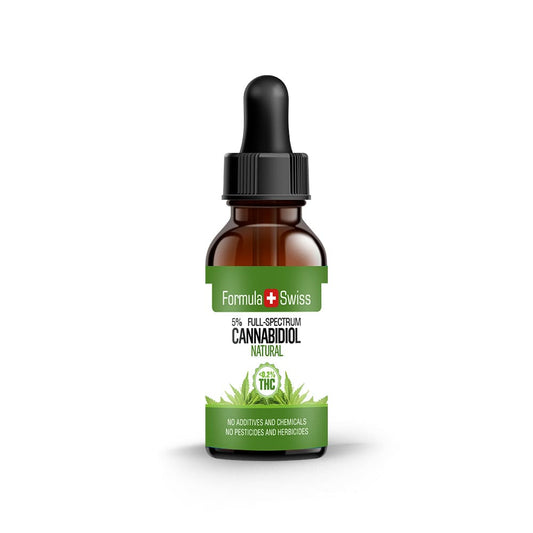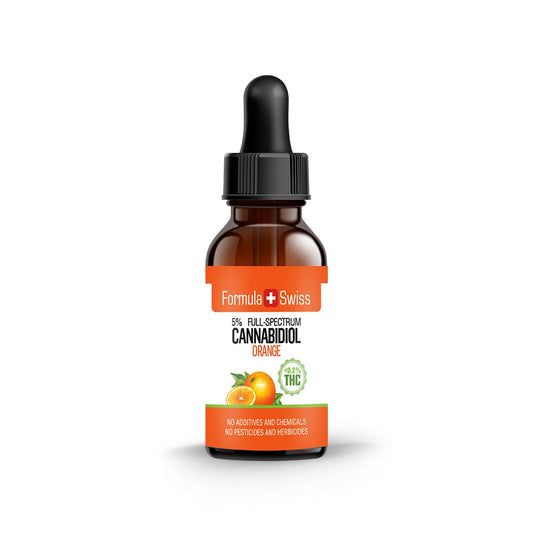There are several different compounds in marijuana, all of which play different roles. Terpenes, for example, provides aroma. Chlorophyll, which is found in the leaves, gives the plant a green color. The most important compounds of all, however, are the different cannabinoids. And in the following article you can learn more about their benefits, their potential and applications for medicine and recreation.
Cannabinoids are active compounds that are found in the cannabis plant and are responsible for its medicinal and recreational properties. You may have heard about the main cannabinoids, cannabidiol (CBD) and tetrahydrocannabinol (THC), but there are many other cannabinoids that are equally important.
1. What are cannabinoids?

There could be as many as 113 different cannabinoids found in the cannabis plant. The most researched of these cannabinoids are by far CBD and THC. The cannabinoids in the marijuana plant are stored in the trichomes, or the crystals of the plant. It’s the trichomes in the cannabis buds that give the plant a specific shine. Most growers focus on producing strains of cannabis with high levels of THC. It’s THC that is responsible for the euphoric “high” feeling you get when you consume marijuana. The other main cannabinoid is CBD. It doesn’t have any psychoactive properties and is 100% legal in many countries around the world. Some other exciting cannabinoids are cannabigerol (CBG), cannabinol (CBN), and cannabichromene (CBC).
The endocannabinoid system and how it works

Endocannabinoids are cannabinoids which are naturally produced by the body. The word “endo” stands for endogenous, which means originating within the body. However, these cannabinoids are different from the cannabinoids found in cannabis, even though they share similar effects and properties. They interact with the same pathways in the body, brain and the central nervous system. These pathways are known as receptors. The most studied endocannabinoids are the anandamide and 2-AG. Some of the other endocannabinoids are Noladin Ether, Virodhamine, and N-Arachidonoyl dopamine (NADA). All those endocannabinoids are responsible for maintaining balance within the body.
The endocannabinoid system is made up of cannabinoids and cannabinoid receptors. The cannabinoids are like keys. They bind with the cannabinoid receptor, unlocking them and causing changes to cell functioning. These changes lead to a variety of different effects throughout the body. When you consume cannabis, THC and CBD enter the endocannabinoid system and bind with the cannabinoid receptors. The two types of cannabinoid receptors are CB1 and CB2. Most of the CB1 receptors, which THC binds with, are found in the brain. CB2 receptors, on the other hand, are spread out throughout the rest of the body, and it’s those receptors that CBD binds with.
What are the major cannabinoids?

There are two main types of cannabinoids. Endogenous cannabinoids, which are produced naturally in our bodies and Exogenous cannabinoids, also known as phytocannabinoids because of their origin from plants.
-
Tetrahydrocannabinol (THC)
THC is one of the best-known cannabinoids linked to marijuana. In some varieties, it can be present in levels as high as 30–40%. Read our article about THC. -
Cannabidiol (CBD)
Another major cannabinoid is CBD. Unlike THC, it is not psychoactive and is often noted for balancing out THC’s stronger properties. Read our article about CBD. -
Cannabinol (CBN)
CBN is not directly produced by the plant. Instead, it forms when THC is exposed to light or heat for extended periods, causing a chemical change. Read our article about CBN. -
Cannabichromene (CBC)
CBC is often found as one of the more abundant cannabinoids after THC. Like CBD, it does not create psychoactive effects since it does not bind with CB1 receptors in the brain. Read our article about CBC. -
Cannabigerol (CBG)
CBG is sometimes described as the “building block” cannabinoid, since it serves as a starting point in the enzymatic process that produces other cannabinoids. Read our article about CBG. -
2-Arachidonoylglycerol (2-AG)
2-AG is an endocannabinoid produced naturally in the body. It can activate CB1 receptors in the brain and is broken down after use. Read our article about 2-AG. -
Anandamide
Anandamide is another endocannabinoid found in humans. Researchers associate it with mood regulation and describe it as playing a role in how people feel during activities such as exercise. Read our article about Anandamide.
Cannabinoids form a diverse family of molecules that share certain core traits. Endocannabinoids are naturally produced by the body and connect with the endocannabinoid system through CB1 and CB2 receptors. These interactions can influence many different processes in the body.
2. What are phytocannabinoids?

Phytocannabinoids are cannabinoids, which are found in both cannabis and hemp. There is a big movement in the scientific community in favor of the medicinal properties of phytocannabinoids. Many countries around the world have started to question the way they view cannabis and its many applications.
Although marijuana was praised for its medicinal properties for centuries, early in the 1900s it was classified by many governments as a narcotic. Only recently have countries turned back to marijuana and its benefits.
Some of the more popular phytocannabinoids are (THC), and cannabidiol (CBD). All cannabinoids which are produced by plants are known as phytocannabinoids.
Some researchers believe that it was a hemp-based diet which allowed our ancestors tens of thousands of years ago to develop an intricate endocannabinoid system we enjoy today.
Below are some of the more common phytocannabinoids and how they react and interact with our endocannabinoid system:
Cannabigerol (CBG)
CBG is considered to be the precursor to most of the other phytocannabinoids. It is believed that it has a wide variety of different therapeutic applications, proving it to be more effective than CBD in managing neuropathic pain. Enzymes located in the trichomes convert CBG into one of the 112 other cannabinoids found in the cannabis plant. After this process, there is very little CBG remaining in the mature plant, normally less than 1%.
Cannabidivarin (CBDV)
CBDV is another non-psychoactive cannabinoid. It is an analogue of CBD and is made out of 3-carbon molecules (propyl), instead of 5-carbon ones (pentyl). CBDV shares many characteristics with CBD, and currently research into its use as an anticonvulsant is being undertaken.
Read our article about CBDV here.
Cannabidiol (CBD)
One of the more well-known phytocannabinoids, CBD has the widest therapeutic application and is currently one of the most studied phytocannabinoids. It’s non-psychoactive, which means that it won’t get you high, like THC would. This makes it legal to buy and possess CBD in many countries around the world. It is currently used to help a variety of different conditions. CBD is utilized as an anticonvulsant, immunostimulant, anti-depressant, antioxidant and as antitumor, anti-psychotic, anti-inflammatory, anti-insomnia, anxiolytic.
Read our article about CBD.
Buy CBD oil here.
Tetrahydrocannabinol (THC)
THC is probably the most well-known phytocannabinoid of them all! When you consume marijuana and get high, the THC in the marijuana is what is affecting you. When the THC binds with the CB1 receptors in the brain, it stimulates the release of endocannabinoids which regulate both our mood and our appetite. THC is also a powerful anti-inflammation remedy, as its efficacy is twenty times bigger than that of an aspirin. THC`s psychoactive properties led to lobbying to have cannabis classified as a narcotic.
Cannabichromene (CBC)
CBC is another therapeutic phytocannabinoid found in cannabis. It is considered by many to be the most powerful anti-cancer cannabinoid. CBC interacts with CB2 receptors in tumor cells, and from that interaction surface antigens are produced. Another interesting fact about CBC is that it is the only phytocannabinoid which is believed to stimulate the growth of brain cells. This wasn’t even considered possible until the late 90s! So this belief has fueled research into the use of CBC as an anti-Alzheimer therapy.
Phytocannabinoids play an important role in our endocannabinoid system, but research into them is still in an early stage, because of its impediment in the last century. As the legalization of cannabis and its reclassification for medicinal purposes continues to grow, more and more research and studies into it are being undertaken.
3. What is THC?

It’s important to note that cannabis is made up of a variety of chemical compounds – more than hundred different ones. Those compounds are called “cannabinoids”. They interact with the receptors in our bodies` endocannabinoid system. These interactions produce different responses throughout our bodies.
Cannabinoids are secondary metabolites. This means that they have no role in the cannabis plant’s growth. Instead, they work as an immune system for the cannabis plant, helping it to fight off pests, parasites, bugs, and predators.
The easiest way to understand the endocannabinoid system is to image the receptors spread throughout the body as locks, and the cannabinoids as keys to those locks. When the right cannabinoids bind to the right receptors, there is a chemical reaction which unlocks the locks.
THC, or tetrahydrocannabinol, is the compound found in cannabis or marijuana that’s responsible for high levels of stimulation on the human brain. An Israeli chemist, Raphael Mechoulam, first isolated and synthesized THC in 1964 by using Lebanese Hashish. His work lead to the discovery of other cannabinoids and also enhanced the research into the endocannabinoid system and its receptors. You may be surprised to learn that our bodies all produce endocannabinoids naturally. One does not even need to smoke cannabis!
THC binds to the receptors in our brain and central nervous system, creating a chemical reaction which many people experience as a psychoactive high. There are also many other reactions which scientists are only just beginning to understand.
When you first experiment with THC, it’s important to take it slowly. Some people may find that using THC can have a relaxing and calming effect; other people experience higher levels of anxiety and paranoia. One interesting fact is that CBD, another cannabinoid found in cannabis, can help lessen the effects of THC. Different cannabis strains will give you different reactions, so it is important to take small steps until you understand how your body reacts.
Effects of THC

Some of the short-term effects of THC usage may include:
- Elation
- Relaxation
- Sedation
- Pain relief
- Memory impairment
- Energy
- Hunger
- Drowsiness
- Increased heart rate
- Dry mouth
- Red eyes
- Slowed perception of time
- Laughter
- Dizziness
- “Couch-lock,” or feeling heavy
- Anxiety/paranoia
THC has many medicinal benefits that are only now being researched. Hundreds of studies into cannabis and its health benefits are being undertaken. Cannabis` rise in popularity and its legalization for medicinal use have been fueling innovation across the medical and pharmaceutical industries.
Health benefits of THC
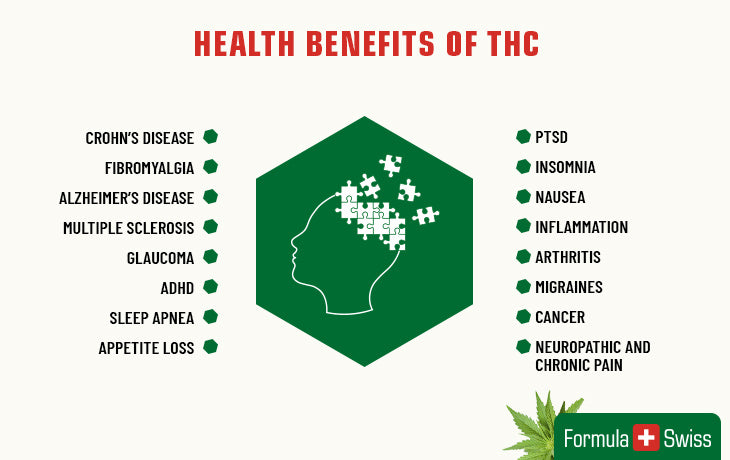
There are several medical conditions, the key to which may be THC:
- PTSD
- Neuropathic and chronic pain
- Insomnia
- Nausea
- Inflammation
- Arthritis
- Migraines
- Cancer
- Crohn’s disease
- Fibromyalgia
- Alzheimer’s disease
- Multiple sclerosis
- Glaucoma
- ADHD
- Sleep apnea
- Appetite loss
4. What is CBD?
CBD or cannabidiol is extracted from the hemp or marijuana plants. It is one of the most important cannabinoids that is found in the cannabis plant. It is not like THC that will cause psychoactive effects.
You will not get high with CBD
The only thing common between CBD and THC is that they are both cannabinoids and they affect the receptors of the brain. They are naturally produced by the human body as well which makes them the part of the endocannabinoid system. It helps to maintain different types of physiological processes. These receptors are naturally found in the nervous and immune system of our body. Once CBD interacts with these receptors you get the effects.
Not only CBD is different from THC, but also research has claimed that CBD can help control the more negative effects of THC like anxiety and paranoia. That is why individuals who are looking for weed with THC will prefer to have the strain that has a reliable ratio of CBD and THC. It helps to maintain the effects THC has on our body and mind.
What does CBD do?
It is important to turn our attention towards what this little yet powerful compound can do before we can get into further details. Recently, CBD is dominating the conversations related to applications od cannabis and CBD in the medical field. However, it does not mean that recreational users do not value the product. There are some unique qualities in CBD that can make it an important part of our daily routine. Using CBD is a natural way of reducing stress and pain. It can help the body feel more relaxed and comfortable by affecting the release of receptors in the Central Nervous System.
5. What is CBN?

Curious about some of the lesser known cannabinoids like CBN? Then let’s check out what CBN is and what some of its medicinal benefits are.
There are approximately 113 different cannabinoids found in the cannabis plant, and all of them can play an important role in our endocannabinoid systems and health and well-being. Like tetrahydrocannabinol (THC), and cannabidiol (CBD), cannabinol (CBN) is one of those 113 cannabinoids. CBN`s properties are similar to those of CBD, because CBN has no psychoactive effect on the brain. So, if your goal is to get high, you may want to pass on CBN. Nevertheless, CBN has other seriously interesting and potentially life-changing medicinal benefits.
CBN is often found in higher amounts in older cannabis plants. As THC ages, or is exposed to oxygen over time, it switches to CBN. So, if you leave cannabis plants unattended for months or years, it is very likely for the THC in them to turn into CBN.
Some of the benefits which scientists and researchers, who are studying CBN, have discovered, include:

- Pain relief
- Promoting the growth of bone cells
- Anti-insomnia
- Anti-inflammatory
- Anti-bacterial
- As an appetite stimulant
- Anti-convulsive
One of the most promising aspects of CBN is its sedative effect. Research into CBN`s properties has gone so far as to suggest that 5mg of CBN could be the equivalent to a 10mg dose of diazepam. CBN`s benefit over diazepam is that the former is a plant-based pain relief and sleeping aid, and the chances of addiction are minimal. Many opioid-based pain relief products also come with severe side-effects and a higher chance of addiction, especially among younger people.
If you like to get a good night’s sleep by using cannabis, a little bit of CBN could be one of the most effective sleeping aids available! Unlike THC, CBN does not affect your brain and will leave you with a clear head. Still, there is a downside to CBN - it isn’t present in nature the same amounts as THC or CBD. While cannabis flower or bud can contain up to 30% THC or CBD, it usually contains less than 1% CBN.
6. What is CBC?

Curious to learn more about CBC and what CBC is? Then this article is worth reading.
Like THC (tetrahydrocannabinol) and CBD (cannabidiol), CBC or cannabichromene is another common cannabinoid found in cannabis. CBC is considered one of the major six cannabinoids, but it is not as researched as either CBD or THC. Scientists are still unlocking all the secrets which CBC and the other cannabinoids are hiding.
Like CBD, CBC isn’t going to get you high or leave you “couch locked” as THC does. It’s a non-psychoactive compound, but nevertheless has a variety of potential health benefits. CBC binds poorly with the CB1 receptors located in the brain. It is more likely to bind with the vanilloid receptor 1 (TRPV1) and the transient receptor potential ankyrin 1 (TRPA1), which have been linked to pain perception. When you consume CBC and it binds with these receptors, the body`s natural number of endocannabinoids increases.
Like other cannabinoids and endocannabinoids, scientists believe that CBC works better when it’s combined with variant cannabinoids. CBC`s reaction to CBD and THC has not yet been researched properly. The growth in the legal medical marijuana markets and the progressive legalization of marijuana around the world is fueling a rise in research and studies.
CBC’s medicinal potential

While research is still ongoing, there are already some potential medicinal benefits linked to CBC. While marijuana has been used medicinally for centuries, it’s classification as a narcotic in the early 1900s has stunted the research on how it works with our bodies and how cannabinoids affect our endocannabinoid systems.
CBC and cancer
CBC could potentially be a very powerful ally in the fight against cancer. This is because CBC interacts with our endocannabinoid system and with anandamide. Anandamide has proved as vital in the fight against breast cancer and CBC could lower its rate of absorption into the bloodstream, which means that anandamide could circulate throughout our bodies for longer periods of time. One study conducted recently showed that CBC could also slow and inhibit inflammation and tumor growth.
CBC pain and inflammation
CBC blocks both inflammation and pain, both of which are associated with osteoarthritis. Using cannabinoids can be a healthier way to handle pain and inflammation, avoiding the nasty side effects associated with prescription medicine and opioid pain relief.
CBC and brain cells
A study from 2013 showed that CBC had a positive effect on mice`s neural stem progenitor cells (NSP cells). Those cells are essential for the healthy functioning of the brain. This could be an important breakthrough in the fight against Alzheimer’s Disease.
CBC and acne
Many cannabinoids, including CBC, have shown to be powerful inhibitors for acne and other skin conditions.
CBC and depression
CBC works well when partnered with THC and CBD as a weapon to help fight mental health conditions such as anxiety, stress, ADD, PTSD, and depression.
7. What is CBG?

Apart from the two most well-known of the cannabinoids, CBD (cannabidiol) and THC (tetrahydrocannabinol), cannabis also contains other cannabinoids such as CBG (cannabigerol). While CBG may not be present in the same quantities as other cannabinoids, it has an important role to play.
CBG is similar to CBD in that it contains no psychoactive properties and won’t give you that feeling that you experience when you consume strains of cannabis with high levels of THC. CBG is usually only found at very low levels, approximately 1%.
The interesting thing about CBG is that both CBD and THC start out as CBG. The cannabis plant produces cannabigerolic acid (CBGA), which is the precursor to three of the most important cannabinoid acids - THCA, CBDA, and CBCA. The enzymes within the cannabis plant turn the CBGA into either CBDA or THCA. The respective acid is then activated by light or heat and turns into CBD or THC. With most strains of marijuana, the CBGA is converted quickly into CBDA or THCA.
In an attempt to get strains of cannabis with higher amounts of CBG, growers and breeders have been experimenting with cross-breeding of plants and genetic manipulation. In order to recover more CBG from cannabis plants, the latter need to be harvested in a certain time during the growing cycle. Growers need to pinpoint when the maximum amount of CBG is present, which is normally six weeks into the eight-week growing cycle.
The potential medical benefits of CBG

Within our bodies, the endocannabinoid system works hard to keep our body balanced in a state of homeostasis. The endocannabinoids help control different areas of the body, with nerve receptors spread throughout the brain and the torso. CBG influences specific areas of the body, and there has been a lot of promising research focused on this area.
CBG and Glaucoma
CBG is a very powerful vasodilator and has many neuroprotective benefits. As there are endocannabinoid receptors located within the eye structure, it is believed that CBG is one of the best cannabinoids for supporting glaucoma by decreasing the intraocular pressure in the eyes.
CBG and Inflammatory Bowel Disease
During a recent study on mice, scientists discovered that CBG was effective in decreasing the inflammation characteristics of inflammatory bowel disease.
CBG and Huntington’s Disease
Huntington’s disease is characterized by nerve cell degeneration and damage in the brain. During a 2015 study on mice, researchers discovered that CBG protected the neurons and hindered the nerve cell degeneration.
CBG and Cancer
CBG has, too, proved valuable in the fight against cancer – it blocks the receptors which are responsible for cancer cell growth and inhibits that growth.
8. What is 2-AG?

2-Arachidonoylglycerol or 2-AG is one of the main endocannabinoids and is part of the endocannabinoid system along with anandamide. 2-AG interacts with both types of CB receptors located in the central and in the peripheral nervous systems in our bodies. 2-AG is an agonist for both CB receptors, and is the primary binding molecule for the CB2 receptor.
2-AG is among the molecules which are extracted from either arachidonic acid or two other 20-carbon essential fatty acids - DGLA and EPA. These molecules are called “eicosanoids” and are oxidized versions of the essential fatty acids. They play important roles in different bodily functions and processes such as immunity or inflammation.
Being one of the most abundant endocannabinoids in our bodies, 2-AG plays an important role in the regulation of appetite, pain management, and immune system functions. There are several different ways to boost the levels of 2-AG in your body. Cannabis is one of those options, but there are also ways to help your endocannabinoid system without cannabis:

Your diet
Because 2-AG is essentially made from fats, or metabolized linoleic acid, you can eat foods high in linoleic acids like eggs, poultry, grains, and hemp seeds. To boost your levels of 2-AG, diets high in omega-6 essential fatty acids is a great way to start. Remember to consume equal amounts of omega-3 and omega-6 fatty acids to get the most benefits for your endocannabinoid system.
Probiotics
Some research suggests that probiotics help to increase the function of CB2 receptors located in the gut. You can eat pre-biotic foods like leeks, artichoke, onions, and garlic. It also helps to eat a lot of high-fiber green vegetables.
Sleep
Quality sleep plays an important role in supporting balance within your endocannabinoid system. Aim to maintain a consistent routine and ensure you get enough restful sleep each day.
9. What is Anandamide?

If you are interested in learning more about endocannabinoids like anandamide and the endocannabinoid system, then just keep reading.
N-arachidonoylethanolamine (Anandamide), is an endogenous analog of THC. Interestingly enough, anandamide is also known as the “bliss molecule”, or the body`s own version of THC. Anandamide is produced by our bodies and is very similar to THC in its chemical content. It binds itself to the same receptors in the endocannabinoid system and could act as neurotransmitter and mood-enhancer.
Unlike THC, CBD, CBN, anandamide is an endocannabinoid. Cannabinoids are found in the cannabis plant, while endocannabinoids are produced naturally by our bodies. Anandamide is produced inside the cell membranes and tissues of the body. It’s synthesized from N-arachidonoyl phosphatidylethanolamine and broken down by fatty acid amide hydrolase, an enzyme.
Anandamide interacts and binds with both types of cannabinoid receptors in the brain (CB1 and CB2). Anandamide is considered a fragile compound as, once absorbed by the body, it quickly breaks down to its components. Anandamide is produced in the part of the brain which is responsible for memory, movement control, and advanced thought processes. Moreover, anandamide plays an important part in many physiological processes such as managing the appetite, managing pain, as well as fertility.
How anandamide works in the human body

Anandamide works by interacting with the receptors which are part of the endocannabinoid system. These receptors are located in the brain and throughout the torso. They act like locks, and the cannabinoids and endocannabinoids act like keys to these locks – the cannabinoids and endocannabinoids bind with the receptors and create chemical reactions. In the central nervous system, the anandamide mostly binds with CB1 receptors, while in the peripheral it binds with CB2 receptors.
According to an article published in the Journal of Clinical Investigation in 2005, anandamide was believed to help promote neurogenesis. The article stated that anandamide, among other cannabinoids, promoted neurogenesis in the part of the brain which is responsible for managing our memory, our ability to learn, and our emotions. They were also shown to have some antidepressant-like effects.
A 2007 paper which was published by the research department at the University of Michigan stated that anandamide plays an important role in establishing our eating habits and in generating feelings of pleasure and motivation. The study showed that a certain amount of anandamide, injected into the forebrain of a mouse, later doubles the span of its reaction when it received a reward for completing a set task. Nevertheless, the anandamide did not affect the mice`s reaction when they didn’t receive a reward.
Other studies, carried out at the University of California and the University of Connecticut, discovered that increased amounts of anandamide in the human brain could help with the relief of the symptoms associated with anxiety and depression.
Ways to increase anandamide levels in your body

If after reading about all those studies which advocate the potential health benefits of anandamide, you would also want to try and increase the levels of this endocannabinoid, there are a few easy ways to do that:
- Exercising
- Eating dark chocolate
- Eating truffles
10. Conclusion
Although the cannabinoids vary in properties, uses and benefits, all of them, as part of the cannabis plant, offer the opportunity to help medical conditions, pain, anxiety, etc without the use of artificial substances. So the next time you are looking for alternative options for medicine, try one of the cannabis products – you will not regret it!



